Serial Maintenance
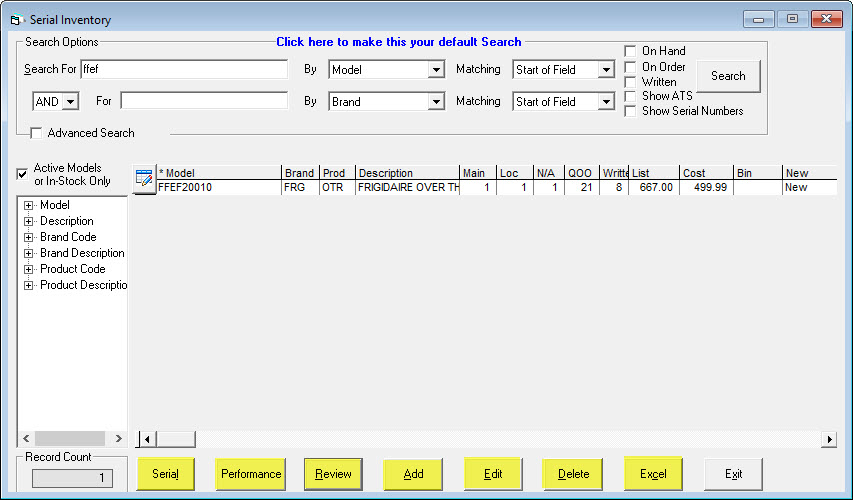
In addition to searching for models, you can review, add, edit, delete, and export the information you find. You can also view the serials you have for this model and how well this model has been selling. Note that you cannot delete any model that has a quantity on hand, a quantity on an invoice, or a quantity on order.
While you can add a single model from this maintenance screen, it's more efficient to import model information from a supplier's price list, especially when adding multiple models at a time. See Creating a Price List Template for more info.
Serial
Clicking this button with a model highlighted will show you the serials you have on hand, their locations, and options to reserve/unreserve, review, edit, and use price protection. See Serial for more info.

Performance
Clicking this with a model highlighted will show you an overview of how many of this model have been sold, when it was last received, and additional details.
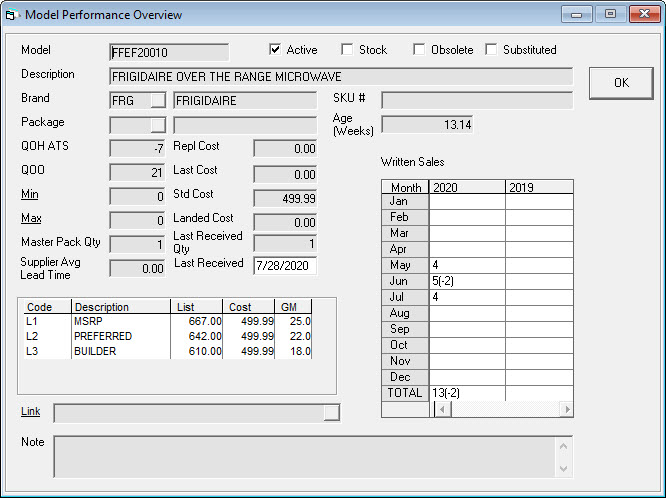
Review
Click this button to open the Model screen where you can view a model's attributes.
Click the Edit button if you need to change or update a model's attributes.
Model Screen
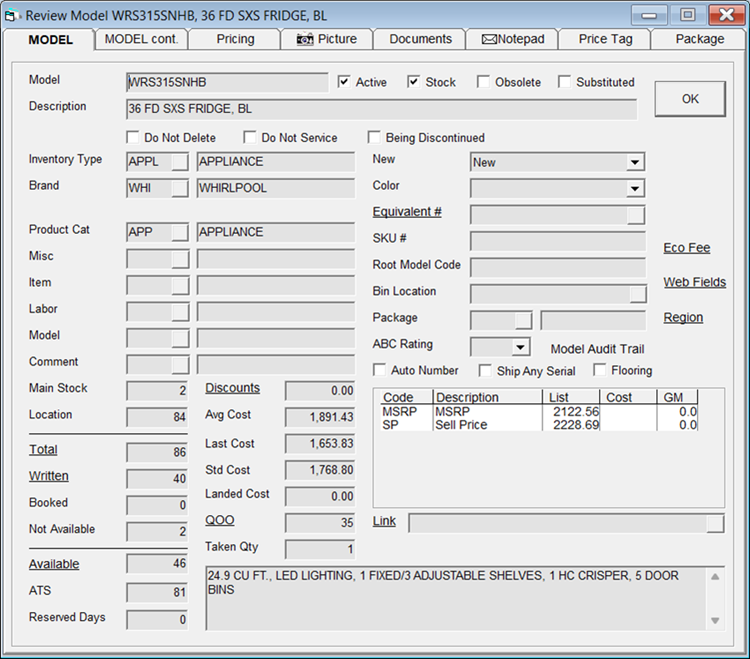
Model Tab
Model
This is the model code with a maximum of 20 characters.
Active (Checkbox)
Typically selected when importing from a Price List Template. When active, it means the model is carried by the manufacturer. It can be unchecked if the manufacturer no longer carries the model. There are rules in Tools > System Maintenance > Variables > Invoicing relating to how this flag affects invoicing.
Stock (Checkbox)
Indicates that your company carries this model as part of your core inventory. You will commonly set min/max levels for this model. There are rules in Tools > System Maintenance > Variables > Invoicing relating to how this flag affects invoicing.
Being Discontinued (Checkbox)
Indicates that your company is discontinuing the selected model soon. A message will appear when a salesperson selects the model on an invoice.
Obsolete (Checkbox)
Indicates that your company does not sell that particular model. There are rules in Tools > System Maintenance > Variables > Invoicing relating to how this flag affects invoicing.
A system message is added to the Model Notepad when this setting is changed, including the name of the user who made the change and when it was made.
Substituted (Checkbox)
Used when the model is being substituted by another model by the manufacturer or if the model was created incorrectly and needs to be fixed. Selecting substituted allows you to choose the substituted model. This is similar to Serial Inventory > Update Key but does not update previous invoices and purchase orders.
Description
Allows you to describe the model with a maximum of 50 characters. Usually filled in when importing from a price list.
Inventory Type
Used by companies that sell different types of inventory like furniture, appliances, and electronics. It helps separate inventory and assign different GL codes. Set up in Tools > System Maintenance > Tables > Inventory Types.
Brand
Specifies the brand for the model, connecting it to the markup table and determining the selling price. Changing the brand can change the selling price. Set up in Tools > System Maintenance > Tables > Brands.
If you see This model is NOT UMRP, it means the brand follows UMRP pricing, but this model is an exception.
Product Category
Specifies the product category for the model, such as Gas Cooktop. Set up in System Maintenance > Tables > Product Category.
Related Items
Includes misc., item, model, comment, and extended warranty on the Model Cont. tab. These fields can be imported by the price list and are related to the model in some way.
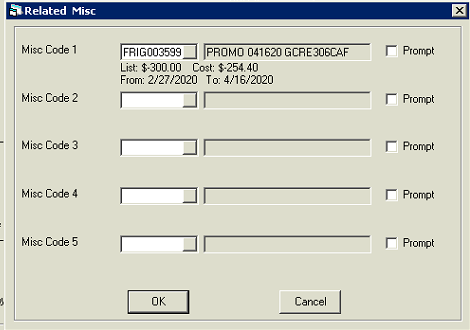
Clicking on any related item box will show a similar box. Each category allows up to five related items. The Prompt checkbox controls whether it will be automatically added to the invoice or if the user will be prompted.
Examples:
- Misc.: A rebate for the model.
- Item: A mounting kit for a TV.
- Model: A stacking washer and dryer.
- Comment: “There will be a 25 percent restocking fee for all returns.”
- Extended Warranty: A 5-year extended warranty.
Main Stock
Shows the quantity on hand (QOH) at your main warehouse.
Location
Shows the quantity on hand (QOH) in all other locations.
Total
Total of main stock plus all other locations. Click on Total to see serial numbers in detail.
Written
Hyperlink showing how many of the model are on open invoices. Clicking it lists all invoices with options to review or edit.
Booked
Shows if the model has been shipped on an invoice without a serial number assigned. Assign the serial number through Serial Inventory > Sales Changes.
Not Available
Shows how many serial numbers for the model are not available to sell, possibly due to damage or location restrictions.
Available
Shows how many of this model are available for sale, calculated by QOH minus written. Click the hyperlink to see the list.
ATS (Available To Ship)
Shows how many of the model are available to ship, considering QOH, written, reserved serial numbers, supplier lead time, and quantity on order. See ATS.
Reserve Days
Part of the Available to Ship calculations, representing how many days it takes to receive replacement stock. Overrides the reserve days at the supplier level for models with long lead times.
Discount
Can be a percent or dollar amount, used for various discounts like trailing, end of month, truckload, instate rebates, volume rebates, etc. Normally imported through price list templates. Defined in Tools > System Maintenance > Variables > Purchasing > Discount Labels tab. Assigning a discount to a model overrides supplier discounts. See Supplier Discounts.

Average Cost
Average cost of all serial numbers currently on hand for this model, maintained by EPASS.
Last Cost
Cost of the last serial number received for this model, maintained by EPASS.
STD Cost
Standard cost, sometimes referred to as salesperson’s cost, imported from price list templates or manually edited. Not maintained by EPASS and usually an inflated cost to hide the actual cost from salespeople. Used in commission and sales analysis reports.
Landed Cost
Optional cost field considering freight or duty charges, imported through price list template or manually added.
QOO
Quantity on Order, a hyperlink showing how many pieces are on order for the model. Clicking it shows all purchase orders with the model, with options to review or edit.
Taken Qty
Shows how many serial numbers for the model have a status of taken, meaning they are assigned (shipped) to an invoice but not finished. These serial numbers are also in the Total hyperlink. Run Invoicing > Reports …1 > OE-10 Shipped Serial report to see all taken serial numbers.
New
Shows if the model is new, used, damaged, or accessory. Imported through price list templates but not commonly used anymore as serial type is assigned to each serial number within the model.
Color
Shows the color of the model, normally imported through a price list.
Equivalent
Shows if there is an equivalent model in EPASS, possibly a new model substituting the current one.
SKU
Allows you to put in an in-house model number. EPASS can help set up the SKU using utilities to automatically populate it. Enabled in Tools > System Maintenance > Variables > Serial Inventory > General tab > Auto Assign SKU Number. Contact technical support to populate the SKU field for existing model numbers.
Root Model Code
Model number without color codes, used by General Electric as part of their price list templates but not required.
Bin Location
Shows the bin location where the model is usually stored, not required as bin locations are usually used at the serial level.
Package
Shows if the model has a package attached, similar to related items. Selling the model also sells the package. For example, a BBQ may have a ‘Tank & Cover package’ including a BBQ tank, cover, and assembly services.
ABC Rating
Manually populated or calculated by the Serial Inventory > Utilities > Update Model ABCD Rating utility.
Eco Fee
Allows you to add an ECO fee on models if required by your state or province. ECO fees must be defined per branch. Set up in the Miscellaneous Table. Added every time the model is added to an invoice.
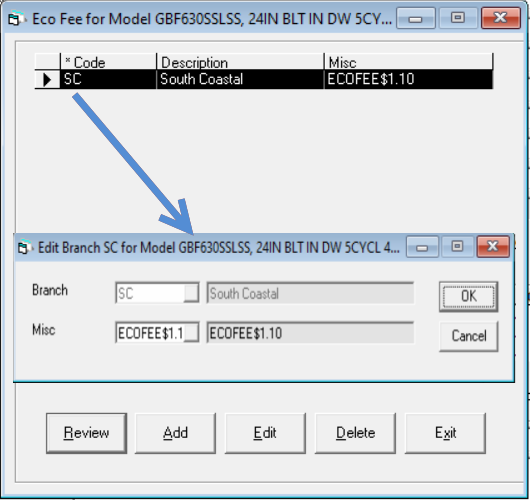
Web Fields
Hyperlink to the Web Fields maintenance screens for the model. Various fields are set up through Web Fields, custom to web interfaces designed by EPASS.
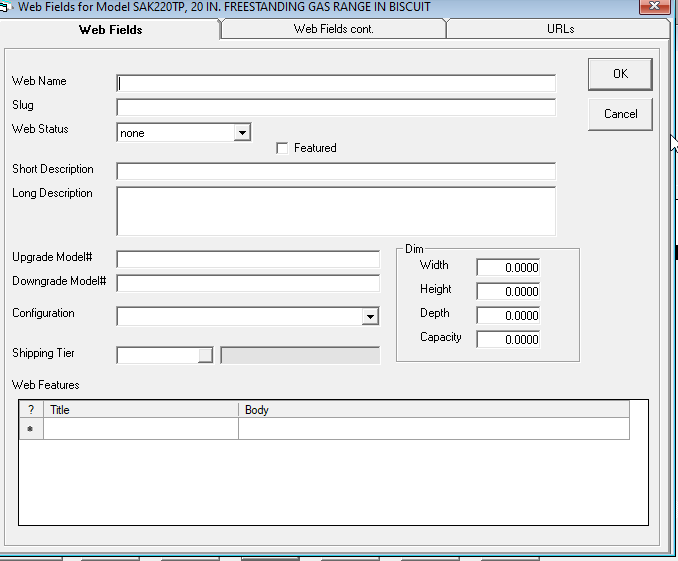


Do Not Delete
Prevents deleting the model from an invoice once added. To delete the model, clear this checkbox first.
This setting does not prevent deleting models from Estimate invoice types.
Model Audit Trail
This hyperlink allows you to see the audit trail for the model you are reviewing.
Auto Number
Checked if the model does not have regular serial numbers from suppliers (e.g., water filters). EPASS will automatically add the next 5-digit number in the sequence when you receive one of these models.
Ship Any Serial
Use this setting for models where shipping an exact serial number is not required (e.g., hood fans or hose kits). Any serial number can be shipped, and EPASS will automatically link the shipped serial with the reserved serial, eliminating inventory discrepancies.
Flooring
Checked if you use EPASS for selling flooring. The model is sold by square foot or square yard. EPASS will create serial numbers in the background and group them by dye lot. When selling, indicate the dye lot being shipped.
Pricing
Shows the same data as the pricing tab in serial maintenance without options to maintain or edit pricing. Displays prices for the model, including sale prices and their start and end dates.
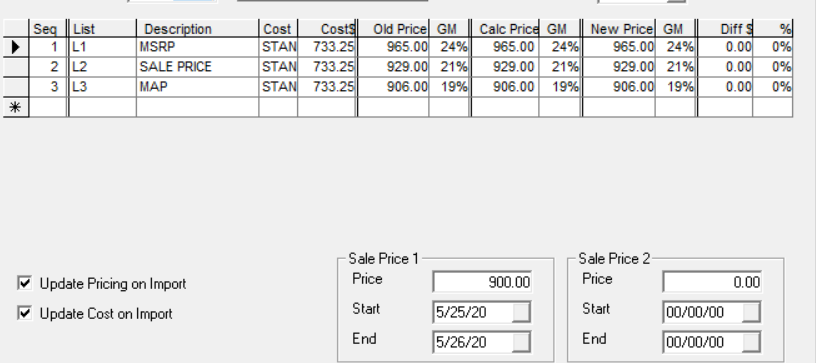
Link
Hyperlink to your website or the supplier's site to see a video or picture of the model.
Important Note
Allows you to show any notes for the model, usually imported through a price list. This note is shown to the salesperson when selling the model.
Model Cont Tab

Supplier
Shows the supplier code for the model. Unlike items, models always have one supplier. Set up in AP > Suppliers > Maintenance.
Warranty Months
Shows how many warranty months the model receives, usually set up through a price list template.
Warranty Types
Used by companies that sell more than appliances. Choose warranty types created in Terminal Settings > Tables > Warranty Types.
Allow Package Wty
Indicates if the model can be part of a package warranty (e.g., a 3-piece warranty for fridge, freezer, and stove).
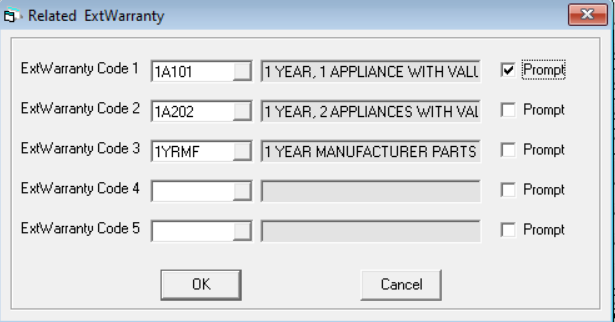
Extended Warranty
Choose extended warranties for the model. Configured in Tools > System Maintenance > Tables > Extended Warranties. If the prompt field is selected, you will be prompted to add the extended warranty when adding the model to an invoice.
Barcode Schema
Set up in the brand table. Can be set up for a specific model, overriding any brand barcode schema.
Shipping Method
Used by Sub Zero part distributors to verify how a part was sent in case of damage.
Min/Max
Shows the minimum and maximum per location for the model. Hyperlinks to the screen showing locations with min/max set up for the model.
EOQ
Economic Order Quantity or lot size. Enter the number of units to order at a time. Information only.
QOO
Quantity on Order. Hyperlink showing how many of the model are on order.
Returned
Shows how many of these models have been returned to the supplier through a purchase order.
Beginning Year QTY
Shows the quantity on hand at the beginning of the year. Used in reports calculating GMROI. Calculated when running the serial year-end roll utility under Serial Inventory > Utilities > Year-End Roll.
YTD
Shows year-to-date sales for the model. Clicking the hyperlink shows sales since the model was created, broken down by inventory division if needed.
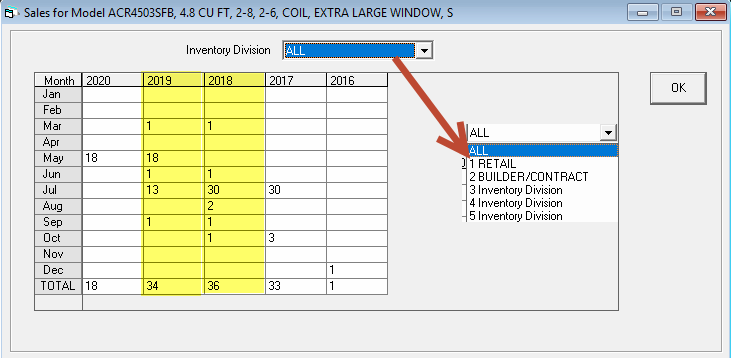
Taxes
Checkboxes to choose which taxes apply to the model. EPASS gets tax information from Tools > System Maintenance > Variables > Invoicing > Tax tab.
Standard Cost
Typical cost for each model, can be overridden at the serial level. Usually imported from Tools > System Maintenance > Tables Price List Templates. Access based on user security.
Original Cost
Base price associated with the purchase of the model. Informational, usually imported from Tools > System Maintenance > Tables > Price List Templates. Access based on user security.
Landing Factor
Used to calculate the landed cost per item, considering freight, duties, and other expenses. Informational, usually imported from Tools > System Maintenance > Tables > Price List Templates.
Landed Cost
Total cost of a product once it arrives, including freight, duties, and other expenses. Informational, usually imported from Tools > System Maintenance > Tables > Price List Templates. Access based on user security.
Replacement Cost
Cost to replace the model at present time. Usually imported from Tools > System Maintenance > Tables > Price List Templates. Access based on user security.
Effective Date
Date the replacement cost becomes effective. Used for seasonal products or advance price lists. Usually imported from Tools > System Maintenance > Tables > Price List Templates.
Spiff
Bonus for a sale, usually from the manufacturer. Imported from Tools > System Maintenance > Tables Price List Templates. Can be given to a salesperson. Two spiff fields for retail and builder sales. Choose which spiff to use through Invoice Types. Access based on user security. Best reviewed in OE-35 Manufacturer Spiffs report.
Actual Spiff
Shows the actual spiff received from the manufacturer. Calculate the difference between the actual spiff and what is given to salespeople. Imported from Tools > System Maintenance > Tables > Price List Templates. Access based on user security.
Points
Accumulates product on a truck to determine if the truck is full. Tools > System Maintenance > Tables > Department must have Accumulate Points for Call Units checked. Points are usually filled out in Tools > System Maintenance > Tables > Product or Miscellaneous table. See Using Points vs. Units for more information.
Weight
Weight of the model for use in websites and third-party system integrations.
Volume
Custom field used by some third-party dispatching companies.
Unload Time
Custom field used by some third-party dispatching companies. Enter how long it takes to unload the truck with this model.
Installation Estimate
Custom field used by some companies using EPASS. Allows a salesperson to see the installation estimate when quoting a customer.
Barcode
Not used much as most companies use the EPASS barcoding system. Enter the barcode for the model; scanning this value will bring up the same model.
Mfg Barcode
Informational only, not used much as most companies use the EPASS barcoding system. Enter the manufacturer’s barcode from the product box.
UPC Barcode
Not used much as most companies use the EPASS barcoding system. Enter the UPC barcode from the product box; scanning this value will bring up the same model.
Last Ordered/Received
Shows the last date the model was ordered/received on a purchase order.
Last Sold
Shows the last date the model was sold on an invoice.
Created/Modified
Shows the user ID and date of the person who created/modified the model.
PO Default Serial Type
Select the serial type that is automatically used when this model is ordered on a PO. This setting is also used when creating a PO order through the OE-04 report, the SN-15 report, the SN-27 report, and the Mass PO Import Utility.
If the PO Default Serial Type dropdown is set to the default value of ALL, then it won't override the PO Serial Type code on the PO header.
Pricing Tab

Markup
Shows the markup table the model uses. Information from Tools > System Maintenance > Tables > Brand > Settings 1 > Serial Markup. If blank, information from Tools > System Maintenance > Variables > Serial Inventory > General > Default Markup. For more information, see Tools > System Maintenance > Tables > Markup.
Cost Type
Cost used by the Markup Table chosen in the markup field. For more information, see Markup Table.
Average Cost
Shows the average cost for the model, calculated from all serial numbers on hand.
Last Cost
Shows the cost for the last serial number received for the model.
Standard Cost
Standard cost for each model, can be overridden at the serial level. Usually imported from Tools > System Maintenance > Tables > Price List Templates. Access based on user security.
Sugg List
Enter a suggested list price. Not commonly done anymore as most companies get cost and prices from Price List Templates. Useful where the supplier only provides a list price and a discount. Enter the suggested list price and discount, then click calculate prices to populate the New Cost and calculate list prices in the grid below.
New Cost
Enter the new cost for the model. Click calculate prices to calculate list prices in the grid below based on the markup table rules. List prices are usually imported from Tools > System Maintenance > Tables > Price List Templates.
Original Cost
Base price associated with the purchase of the model. Informational, usually imported from Tools > System Maintenance > Tables > Price List Templates. Access based on user security.
Landing Factor
Used to calculate the landed cost per item, considering freight, duties, and other expenses. Informational, usually imported from Tools > System Maintenance > Tables > Price List Templates.
Landed Cost
Total cost of a product once it arrives, including freight, duties, and other expenses. Informational, usually imported from Tools > System Maintenance > Tables > Price List Templates. Access based on user security.
Replacement Cost
Cost to replace the model at present time. Usually imported from Tools > System Maintenance > Tables > Price List Templates. Access based on user security.
Effective Date
Date the replacement cost becomes effective. Used for seasonal products or advance price lists. Usually imported from Tools > System Maintenance > Tables > Price List Templates.
List Prices

- SEQ NO: The order of list prices in the table.
- LIST PRICE: List price codes for the model.
- DESCRIPTION: List price descriptions.
- COST: The cost type used by this list price.
- COST$: The cost dollar value used by this list price.
- OLD PRICE and GM: Current price listed and the gross margin based on that price.
- CALC PRICE and GM: New calculated price and gross margin based on the new cost entered.
- NEW PRICE and GM: Enter a new price and have the gross margin calculated based on that price.
- DIFF $ and %: The difference between the old price and the new price in dollars and gross margin.
Sale Price

Allows you to enter two sale prices for the model, usually imported from Tools > System Maintenance > Tables > Price List Templates. Displays the sale price and the start and end dates.
Update Price on Import
Selected by default. Uncheck if you do not want to update the pricing for the model during a price list template import. Used for models with set pricing regardless of cost.
Update Cost in Import
Selected by default. Uncheck if you do not want the various cost fields updated during a price list import.
Picture Tab

Allows you to save pictures of the current serial. Each picture is saved in the database and is not a hyperlink. You can download each picture and save it to disk.
To Add a Picture:
- Click Find Picture.
- Select the image file to upload, then click Open.
To Download a Picture:
- If there are multiple pictures, navigate to the one you want to download using the Arrow buttons.
- Click Download Picture. Navigate to the location to save the image, then click Save.
Click Resize to fit the picture on the screen better. This will not edit the dimensions of the picture, just the preview.
Documents Tab
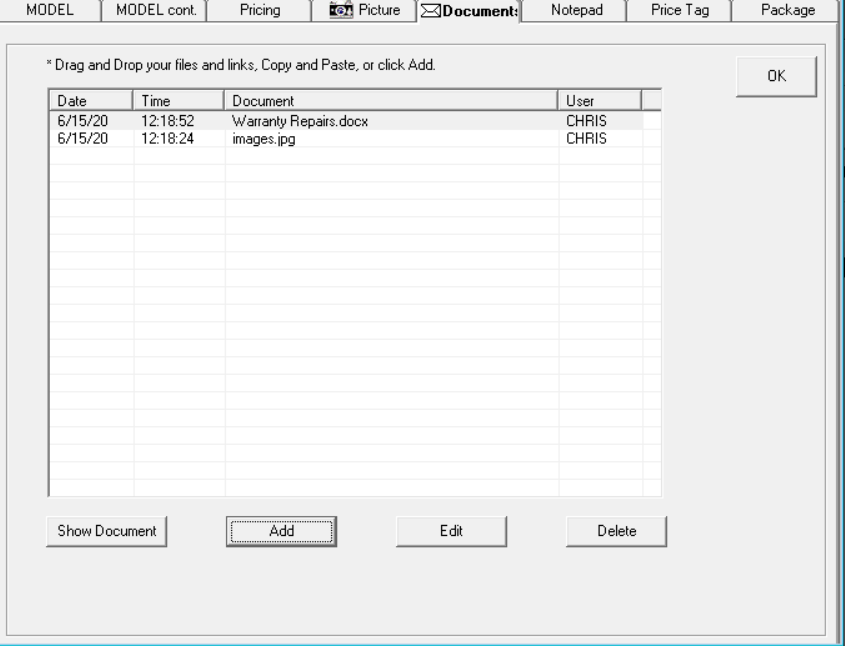
Attach any file type to the document tab. These documents are not saved in the EPASS database. Ensure all staff have access to the shared network path where the document is stored. If a document is attached to the model, a small document icon will appear beside the document tab.
![]()
Notepad Tab
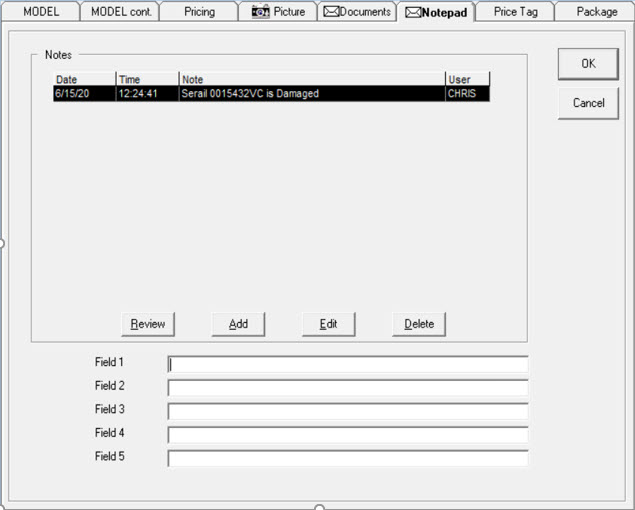
Add notes about the model. The note can be a text document or a Word document. When adding a note, you will see the date, time, actual note, and the user who added it. If there are notes for the model, a small envelope icon will appear next to the heading notepad.
Field 1-5 are customizable, depending on what you want to track for the model. Customize these settings through Tools > System Maintenance > Variables tab > Serial Inventory > Titles. Access is based on user security.
Price Tag Tab
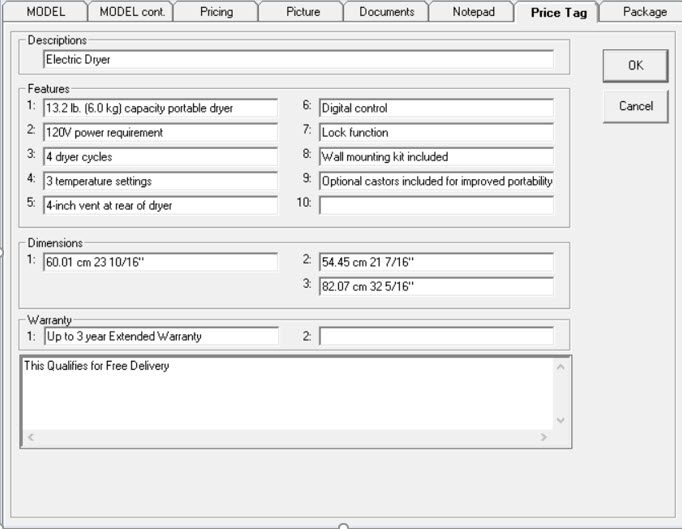
Add features, dimensions, warranty settings, and additional notes for the model. EPASS can use these fields when printing price tags. These settings can also be exported if using electronic price tag systems integrated with EPASS. All printed and electronic price tags are custom designed for each client.
Description
Descriptions can be a longer or extended description field.
Features
List up to 10 features about the model. Examples for a refrigerator might include glass shelves, ice and water, etc.
Dimensions
List up to 3 dimensions about the model.
Warranty
List up to two warranties for the model.
Blank Note
Use this field to enter extra information about the model.
Package Tab
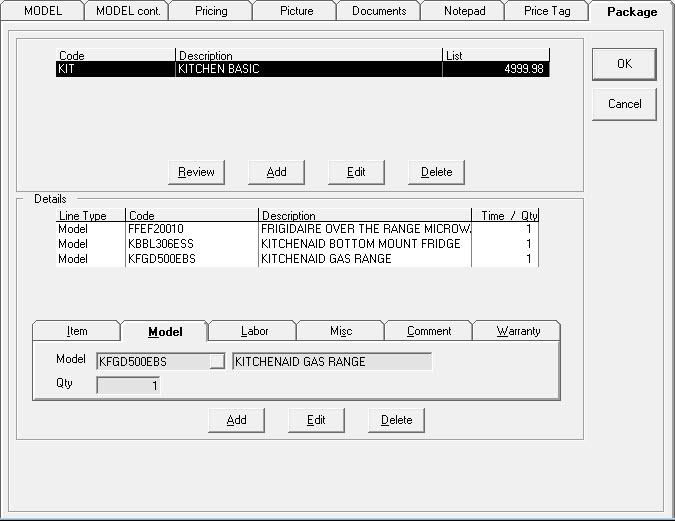
See what packages the model is included in. Useful for upselling a model into a package sale. Packages are normally set up in Tools > System Maintenance > Tables > Package, but you can also add, edit, and delete packages from this screen. Access is based on user security.
See Also
December 2, 2025